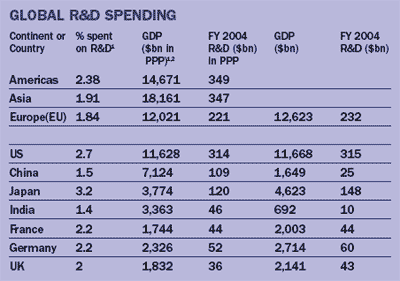Dr Paul F. McManamon says Europe will lag behind Asia and America unless it makes tough decisions in R&D investment

McManamon: 'The rest of the world will not stand still'
PPP is a number used to compare the standards of living of two countries². PPP takes into account both the differences in wages and the differences in cost-of-living. On the basis of PPP you see that Europe is already losing to Asia in total R&D. PPP more accurately represents work done, while hard currency is more important if you want to sell something to the people doing the work.
Where could the three per cent of GDP for R&D come from in Europe? Will industry invest it? Do tax laws in Europe promote industry investing in this manner? This question is critical since, for the EU, 15 industries contribute 55 per cent of the R&D (compared to 63 per cent in the United States).³ The European Union is putting money into Framework programmes. How much money will be invested? Considering the other bills Europe has to pay, such as the integration of the new members into the European Union and the burgeoning social costs for the ageing populations of some of the original EU states, will the EU really make a major investment? Will individual member nations in the EU make a major investment in technology? Will venture capitalists put up the money? Unfortunately so far no one has replicated the venture capital culture of the United States' Silicon Valley. Do the tax laws in any of the European countries promote such a culture? France and Germany are putting 2.2 per cent of GDP into R&D2, which is not bad, but is still far from three per cent. The data R&D magazine has for all of Europe shows only 1.84 per cent for R&D, lower than either the Americas or Asia. Will the people running each of Europe's states value the relationship between R&D spending and wealth creation enough to overcome all of the urgent near term needs for money? These are tough decisions Europe has to make, but the issue may not be when Europe will overtake the United States, as highlighted in the Lisbon protocol. With five years to go it would seem Europe should be further along at developing the R&D technology workforce and its associated investment. Without tough decisions by European leaders, Europe will become the last of the big three continental centres as far as funding to develop technology is concerned, and arguably in high-tech wealth creation and job development. Even with an investment in technology, will Europe be able to translate that investment into industry and jobs? The United States has a strong culture of connection between some key universities and industry. Both Yahoo and Google came out of Stanford University within a decade of each other. European universities tend to be less organically connected to industry. Even if the investment is made in Europe, will the culture allow the required industrial connection, so that this investment translates into new industries and new jobs? The Lisbon protocol sets very desirable goals for Europe. Europe needs to overcome the obstacles and form a realistic path to achieve those goals. The rest of the world will not stand still, but if Europe forms a realistic path to achieve the Lisbon goals, Europe will be a competitive environment for high tech development, including optics.
- R&D Magazine, Sept 2005
- Wikipedia, Nov 23 search, 2005, World Bank numbers
- Financial Times, Dec 2, 2005, page 16

Dr Paul F. McManamon is the incoming president of SPIE, the International Society for Optical Engineering and chief scientist of the Sensors Directorate at the Air Force Research Laboratory.
Please send any comments/feedback to the editor at editor.electro@europascience.com

